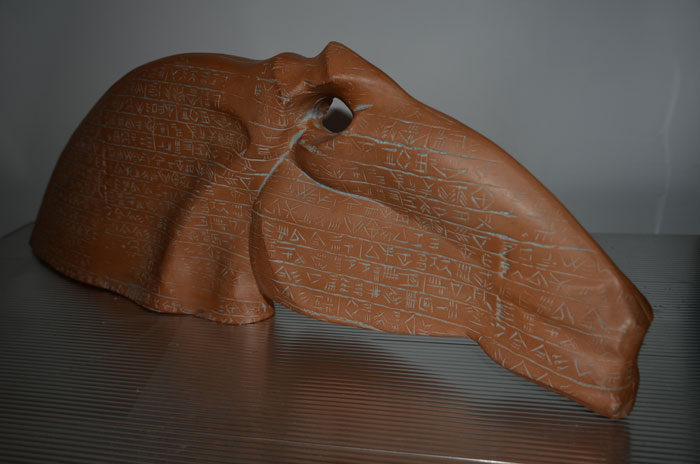Extraordinary success for our exhibitions in the Biennale Architettura 2014
Fundamentally Hong Kong? DELTA FOUR 1984-2044
Happiness Forecourt = Largo da Felicidade = 開心前地
The Space that Remains: Yao Jui-Chung’s “Ruins” Series
With an average of 120.000 visitors in six months.
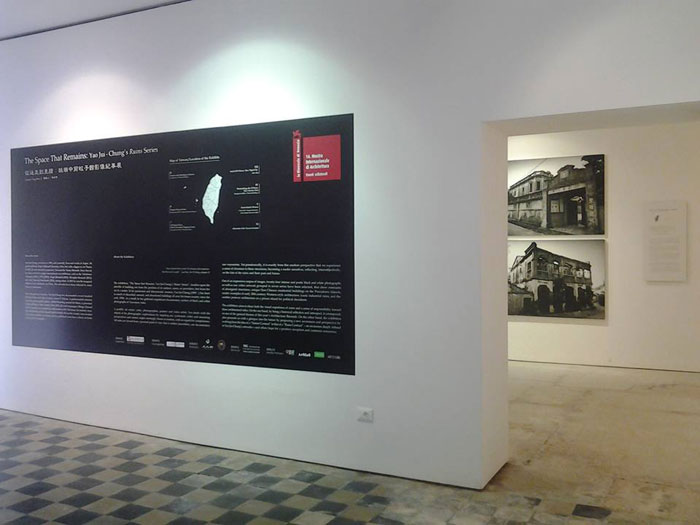
Excerpt from: www.labiennale.org
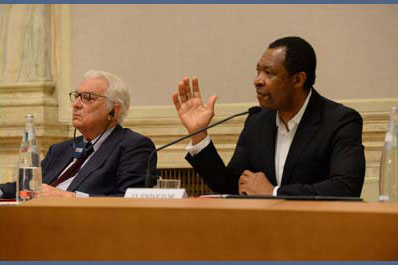
The President of la Biennale di Venezia, Paolo Baratta, accompanied by the curator of the 56th International Art Exhibition, Okwui Enwezor, met today at Ca’ Giustinian with the representatives of the 53 Countries participating in the 56th Exhibition, which will take place from May 9th – November 22nd 2015 at the Giardini and at the Arsenale (Preview on May 6th, 7th and 8th) and in various other venues in Venice.
The title chosen by Okwui Enwezor for the 56th International Art Exhibition is: All the World’s Futures
Okwui Enwezor has explained his project as follows:
«The ruptures that surround and abound around every corner of the global landscape today recall the evanescent debris of previous catastrophes piled at the feet of the angel of history in Angelus Novus. How can the current disquiet of our time be properly grasped, made comprehensible, examined, and articulated? Over the course of the last two centuries the radical changes have made new and fascinating ideas subject matter for artists, writers, filmmakers, performers, composers, musicians. It is with this recognition that the 56th International Exhibition of la Biennale di Venezia proposes All the World’s Futuresa project devoted to a fresh appraisal of the relationship of art and artists to the current state of things».
The Exhibition: Parliament of Forms
«Rather than one overarching theme, All the World’s Futures is informed by a layer of intersecting Filters, these Filters are a constellation of parameters that circumscribe multiple ideas, which will be touched upon to both imagine and realize a diversity of practices. The 56th International Art Exhibition will employ as a Filter the historical trajectory that the Biennale itself, over the course of its one hundred and twenty years existence has run over, a Filter through which to reflect on both the current “state of things” and the “appearance of things».
«How can artists, thinkers, writers, composers, choreographers, singers, and musicians, through images, objects, words, movement, actions, lyrics, sound bring together publics in acts of looking, listening, responding, engaging, speaking in order to make sense of the current upheaval? What material, symbolic or aesthetic, political or social acts will be produced in this dialectical field of references to give shape to an exhibition which refuses confinement within the boundaries of conventional display models? In All the World’s Futures the curator himself, along with artists, activists, the public, and contributors of all kinds will appear as the central protagonists in the open orchestration of the project».
«At the core of the Exhibition is the notion of the exhibition as stage where historical and counter-historical projects will be explored. Within this framework the main aspects of the 56th Exhibition will solicit and privilege new proposals and works conceived specifically by invited artists, filmmakers, choreographers, performers, composers, and writers to work either individually or in collaboration».
Three are theFiltersthat formAll the World’s Futures:
Liveness: On epic duration; Garden of Disorder; Capital: A Live Reading.
Liveness: On epic duration
«All the World’s Futures is both a spatial and temporal manifestation that is relentlessly incomplete, structured by a logic of unfolding, a program of events that can be experienced at the intersection of liveness and display. It will be a dramatization of the space of the exhibition as a continuous, unfolding, and unceasing live event. In doing so All the World’s Futures will activate works that are already existing but also invites contributions that will be realized especially for this Exhibition».
Garden of Disorder
«This Filter, located in the Giardini and the Central Pavilion, Corderie, Giardino delle Vergini in the Arsenale, and selected areas in Venice, takes the historical ground of la Biennale in the Giardini as a metaphor through which to explore the current “state of things ”. The Biennale Arte 2015, returns to the ancient ground of this ideal to explore the changes in the global environment, to read the Giardini with its ramshackle assemblage of pavilions as the ultimate site of a disordered world, of national conflicts, as well as territorial and geopolitical disfigurations. The artists have been invited to develop proposals that take the concept of the garden as a point of departure to realized new sculptures, films, performances, and installations forAll the World’s Futures».
Capital: A Live Reading
«Beyond the distemper and disorder in the current “state of things,” there is one pervasive preoccupation that has been at the heart of our time and modernity. Since the publication of Karl Marx’s massiveCapital: Critique of Political Economy in 1867, the structure and nature of capital has captivated thinkers and artists, as well as inspired political theorists, economists, and ideological structures across the world. A core part of this program of live readings, is “Das Kapital” a massive meticulously researched bibliographic project, conceived by the artistic director in the Central Pavilion».
«With this outlook, All the World’s Futures, through its constellation of Filters will delve into the “state of things” and question “the appearance of things”, shifting from the guttural enunciation of the voice to the visual and physical manifestations between artworks and the public».
«The first International Art Exhibition of the reformed Biennale di Venezia took place in 1999 and it was in that year, at the very beginning of a new chapter in its history, that it found itself having to respond to the many adverse comments it received. Many thought that an exhibition through pavilions was obsolete or at the very least an outdated concept in what was the much heralded era of globalization».
So the President Paolo Baratta has introduced the 56th International Art Exhibition remembering to accepted the criticisms, but not the solutions that some put forward: «we did not throw out the use of pavilions for the Biennale - explains the President – but we enhanced it in a definitive way, by arranging a large, stand-alone International Exhibition at the same time. We arranged additional large spaces and appointed a curator for this ambitious project of ours. A main International Exhibition replaced the international sections, which used to be added to the exhibition organized by the curator of the Italian Pavilion. An international curator for our International Exhibition and no more committees or commissions. The new model worked, and this dynamic, new two-pronged event led to an increase in the number of countries wanting to participate.
It’s been 15 years since that reform, and the start of this new chapter, and it is thanks to that calculated choice that today, a curator of the ilk ofOkwui Enwezor – like his most recent predecessors – can present not just a ‘section’, but an entire International Exhibition inspired by the ambition tooffer the world a global sounding board».
«In that occasion – Baratta continues – the Arsenale became an addition to the Giardini venue, and 15 years on, the number of participating countries, exhibiting in the two venues, is equal: 28 national participations at the Giardini and the same at the Arsenale, on the occasion of the 14th International Architecture Exhibition. Since the Biennale took on this greater and more precise responsibility, the dialogue with the pavilions and participating countries has evolved. The pluralism of voices that now exists is unique to the Biennale di Venezia».
«The Biennale – specifies Baratta – is an Art Exhibition and not an art fair, and as such requires more than an unbiased up-dating of a roster of artists, young or not so young, famous or otherwise. Art and today’s reality present us with far more complex tasks. In the past, we have defined the Biennale in various ways. Today, faced with the dangers of slipping towards a more orthodox popularity, conventionality and security, we have named it “The Machine of Desire” to keep the desire for art high and in turn to want art and accept it is a necessity. In other words, to recognise as both a primary and primordial necessity man’s need to give some perceptible form to utopias, obsessions, anxieties, desires and to the ultra-sensitive world».
«A Biennale is a complex affair– states Baratta. None of the aspects mentioned can be overlooked and whatever the curator’s initial concept – philosophical, political or anthropological – his selection really must include pieces that are necessary and fundamental to our perception. The introduction of the Biennale College is proof of our increasing commitment to new generations of artists. The current Architecture Exhibition has enjoyed the addition of the Dance, Theatre, Music and Cinema sectors. The next Art Biennale contain various forms of art but as an integral part of the exhibition».
Baratta concludes: «It is not the first time that an exhibition faces a world filled with uncertainty and turmoil whilst the “garden of the world” appears to us as a “garden of disorder”, and it is also not the first time that faced with a complicated reality, an exhibition responds with the enthusiasm and dynamism evident in the one we are in the throes of organizing».
The 56th International Art Exhibitionof la Biennale di Venezia will also present, as is traditional, the National Participations with their own exhibitions in the Pavilions at the Giardini and at the Arsenale, and in the historic city centre of Venice.
This edition will also include selected Collateral Events, presented by international entities and institutions, which will present their exhibitions and initiatives in Venice concurrently with the 56th Exhibition.
Official website: www.labiennale.org
By Chika Okeke-Agulu PrincetonUniversity Professor/ Blogger, Ofodunka
Excerpt from: http://www.huffingtonpost.com
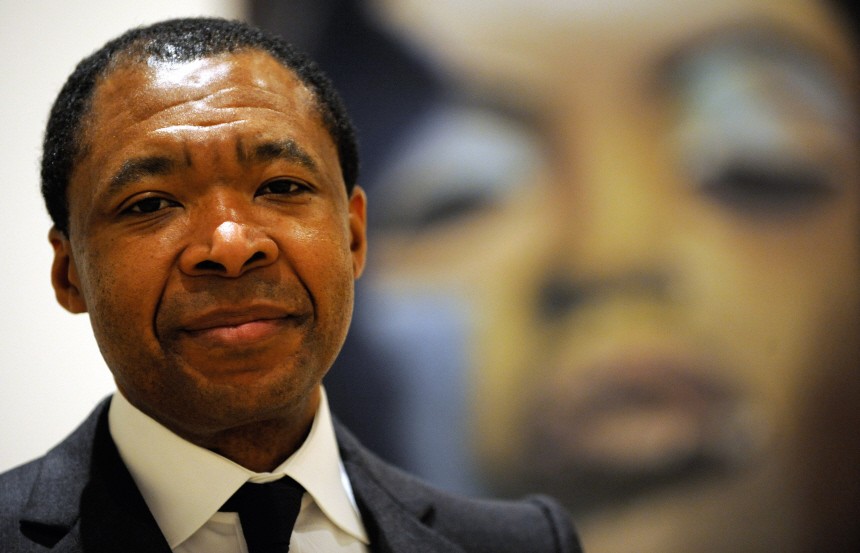
On Wednesday, December 4, the Press Office of the Venice Biennale announced the appointment of the Nigerian-born curator and scholar Okwui Enwezor as the director of the 56th Venice Biennale scheduled for 2015. In this interview, Enwezor discusses his career and the significance of his latest curatorial project.
Chika Okeke-Agulu: At the opening of Documenta11 in 2002, I remember saying to you that the next big challenge would be Venice. I said it as a kind of joke, but not because I did not think you could do it. Rather I was aware that only one other person--the legendaryHarald Szeemann--had curated both Documenta and Venice. In any case, since Documenta you have organized Gwangju and Seville Biennales, as well as La Triennale, Paris, and now, Venice. I cannot imagine what it feels to join Szeemann in this curatorial pantheon?
Okwui Enwezor: Thanks Chika. That's extremely kind of you to make a comparison with me and Szeeman. I know this question will inevitably come up, and I want to be as clear as possible, I belong to no pantheon. There really isn't a comparison; Szeeman is entirely in a league by himself. In the abundance of his ideas, the almost carnal fervor for artists, artworks, and objects of all kinds, along with his bold, original curatorial experiments, he paved the path to the thinking that curatorial practice need not be too studied, formalist or dogmatic.
The fact that we are the only two curators to have helmed both Documenta and Venice Biennale is a historical happenstance; but one whose significance is still settling in. It is of course, a great honor to be entrusted with the task of organizing an exhibition of this magnitude and international acclaim. Nevertheless, it is not lost on me that there is some kind of meaning in the symbolism to which you drew attention. Exactly 15 years ago, I got handed the reins of organizing Documenta. I was 35 at the time, I had limited track record, no major institution, patron, mentor, behind me, yet somehow that amazing jury that selected me saw beyond those deficits and focused, I hope, on the force of my ideas, and perhaps even a little wager on the symbolism of my being the first non-European, etc. My sense of it was that the jury wanted a choice that could be disruptive of the old paradigm but still not abandon the almost mythic ideal of this Mount Olympus of exhibitions.
I came to Documenta as I said with little track record, but with an abundance of confidence. Now at fifty, I come to Venice with a different set of lenses and experience. As you mentioned I have now organized quite a number of biennials. It's time to get to work.
C. O.: Documenta11 was one of the few exhibitions that have been called game changers in the history of curating. And this, I believe had to do with your introduction of the multiple platforms scattered across the globe, as the constitutive sites of an event that until then only took place in Kassel. What are your preliminary thoughts about how you might approach Venice, given its history and structure?
O. E.: It's too early to say what shape the 56th Venice Biennale will take. Of course, I have some preliminary ideas, but those will be worked out in due course. The one virtue of Documenta is the time allowed to organize it, which made possible the platforms. But you must remember that the platform idea, which was fundamentally about the deterritorialization of Documenta, was not initially endorsed by certain landlocked critics, but once it took off its implications about going beyond business as usual became abundantly clear. I drew enormously from the Igbo saying: "Ada akwu ofuebe ekili nmanwu." The mobility of the platforms across major cities and some not so major ones was premised on this principle. To see the artworld properly as it should be, to engage in meaningful debate the curator must risk the sense of inquisitive wanderlust. However, Venice is an Island, but also a legendary maritime trading city that historically looked out to the rest of the world. The limited time permitted to organize the biennale produces a certain sense of temporal density. I am certainly thinking about how to surmount this conundrum.
C. O.: Looking at the trajectory of your career, from the early 1990s when, with a few friends and colleagues working in the margins of the contemporary art world, you founded Nka: Journal of Contemporary African Art, to becoming a leading academic, administrator and curator in the field of contemporary art, does it sometimes feel like an improbable story?
O. E.:All stories are improbable. Nothing is preordained. No one is born with a straight arrow in his quiver. It's a combination of relentless work and good fortune. Without this improbability there is no risk, no adventure, no discovery. I am an autodidact which was the basis of my ceaseless and restless appetite for ideas. I learned enormously about art, not in an art history seminar (I don't even recall actually taking one) but by seeing enormous number of exhibitions, being in the presence of art and artists every week, everywhere. I still do, and I maintain the exercise of seeing, reading, thinking, and writing.
I arrived in New York in late summer of 1982, at a pivotal point in the development of contemporary art, fashion, performance, music, etc. in the city. I was a beneficiary of the perfect storm of creative upheaval: art, postmodern and postcolonial theory, identity politics: race, sexuality, gender, queer and feminist activism, and the AIDS pandemic further refreshed my perspective on difference and politicized my response to injustice. This was the context that opened me up to complexity and taught me to be courageous and fearless.
Also, Coming from Nigeria I felt I owed no one an explanation for my existence, nor did I harbor any sign of paralyzing inferiority complex. What was apparent was that most Americans I knew and met were actually not worldly at all, but utter provincials in a very affluent but unjust society. And when this became clear I saw no reason why I could not have an opinion or a point of view. I was not about to be respectful of ignorance of Africa or prejudice against African culture. This gave me some chutzpah.
I started learning about what was going on in downtown New York across every cultural and literary sphere through publications like Village Voice, Detail, Seven Days. I attended openings, went to readings, saw an enormous number of exhibitions, in every imaginable context, from apartments to Soho galleries, to alternative spaces to museums, nightclubs such as Danceteria, Area, Pyramid Club, Peppermint Lounge, Palladium, Save the Robots, The World, Roxy, Madam Rosa's, and later Nell's, Mars, you just name it. I was educated as it were in situ. I can actually say that I was there.
At some point this intense experience as a young Nigerian who was deeply interested in art and all types of the creative process ceases to be a fluke. I don't believe in standing on the margins. You should also know that what partly made Nka viable was that I did actually have a deep knowledge of international contemporary art. I was not pretending. When I started thinking of setting up Nka in 1991 when I was in my twenties, I was intellectually ready and had a certain theoretical grounding and immersion in art, visual culture, etc. I was already collecting a bit of photography and some art. My first major acquisition was the portrait of Jean-Michel Basquiat by James Van der Zee from Howard Greenberg Galleryon Wooster Street. I would go to the Comme des Garçon boutique downstairs to shop and up to the Greenberg Gallery to browse vintage prints by Cartier Bresson, Kertescz, Weston, Moholy Nagy, Baron de Meyer. So with Nka It wasn't as if I did not know what I was talking about. The only reason it also worked was because I had the language and it was fresh and people were open to giving it audience. That it led to where I am standing today is both surprising and thrilling. But we are nearly thirty years into this story. The novelty of endless looking back is wearing off. Obama's campaign slogan in the last election against the hapless Mitt Romney had it exactly right: Forward.
C. O.: Are you going to retire from curating biennales after Venice?
O. E.: I am not the retiring type.
Press release
Chen Ting-Chang, Winner of the Arte Laguna Special Youth Prize at the Occasion of the OPEN 17. International Exhibition of Sculptures and Installations, 2014
CHEN Ting-Chang (1990 - ) is one of the most talented young artists of his generation in contemporary Taiwanese visual art. Currently a post-graduate in the Department of Chinese Ink Painting and Calligraphy, National Taiwan University of Arts, Chen has won prizes at numerous competitions in the past few years. Recently, he has further experimented with various media such as light and sound installation, interactive work, sculpture, and performances. Not being-in-the–world, but rather the sheer mysterious existence of human life has become a central theme to his artistic creation and also the main focus of his poetry. One of his favorite works of Western art is Piet Mondrian’s Tableau 2 (1922) at the Guggenheim Museum, Venice, not least because the interplay of black and white conveys a constant flux that reminds him of the black-and-white dynamics of Chinese ink painting.
In The imitation of the Grand Silence, the work that won him the Arte Laguna Special Youth Prize on the occasion of the OPEN 17. International Exhibition of Sculptures and Installations, 2014, Chen Ting-Chang has succeeded in dealing with the existential and physical presence of human beings whose gaze is not determined by desire but first and foremost by light – by a specific light in a given time and space. By piling up small grids or compartments of transparent acrylic filled with a likewise transparent wax-like fluid, positioning them on top of a naturally-colored inverted mountain, and lastly enclosing them in a grand geometric acrylic box, transparent as well, Chen delineates a world of ‘living’ grids/spaces/times that all look different depending on the actual angle of light incidence and reflection as well as the viewer’s own angle of vision.
Chen has described the possibilities of perceiving the many divers nuances of light parallel to our human gaze, nuances that accompany our life from beginning to end, as follows:
Born in the gaze
The grand silence
Seeing interpretation as real
Space compares with time
This is the arch-form of contradiction
He is born
Imitating time in eternity
As the recipient of the Arte Laguna Special Youth Prize, Chen Ting-Chang will be invited to participate in the upcoming Arte Laguna Finalists Exhibition at the Arsenale, Venice, in March, 2015.
CHEN Ting-Chang
Artist’s statement
I consider artistic creation an opportunity.
It is not about producing something that expresses what I think here and now,
but rather it is like looking into what I have thought before.
While looking in this way, I experience anew, if from a distance, an interpretation of what were my former attitudes toward things and human beings.
For me, artistic creation is not limited to expression and production.
Rather, it means to be the recipient of a powerful message.
This message tells me that ultimately I can see only by myself and that what
I see is just one specific angle of interpretation.
CHEN Ting-Chang
Born 1990, in Taoyuan, Taiwan. Lives and works in Taipei, Taiwan.
Currently graduate studies at the National Taiwan University of Arts (Painting and Calligraphy Dept.)
Exhibitions
2014 The Grand Art Exhibition of New Taipei City, New Taipei City Art
Center, Taipei, Taiwan
2014 Human- Beings are Not Human- Beings, A Joint Exhibition of Nine
Artists, Xinzhuang Art Center, Taipei, Taiwan
2013 Existence of Upside Down Upside Down, National Taiwan University of
Arts, Taipei, Taiwan
2013 The Art Exhibition of New Taipei City, New Taipei City Art Center,
Taipei, Taiwan
2012 That Year, A Joint Exhibition of Chen Ting-Chang and Shen Xiao-wen,
Yilan County Arts Center, Yilan, Taiwan
Awards
2014 Arte Laguna Special Youth Prize, Venice, Italy
2013 First Prize, New Taipei City Art Exhibition - Ink Painting, Taipei, Taiwan
2013 First Prize, Department exhibition, National Taiwan University of Art, Taiwan
2012 First Prize, Department exhibition, National Taiwan University of Art, Taiwan
2011 First Prize, Department exhibition, National Taiwan University of Art, Taiwan
Collection
2014 The Imitation of the Grand Silence, International University Venice, Italy
2013 Dust Action, National Taiwan University of Arts, Taipei, Taiwan
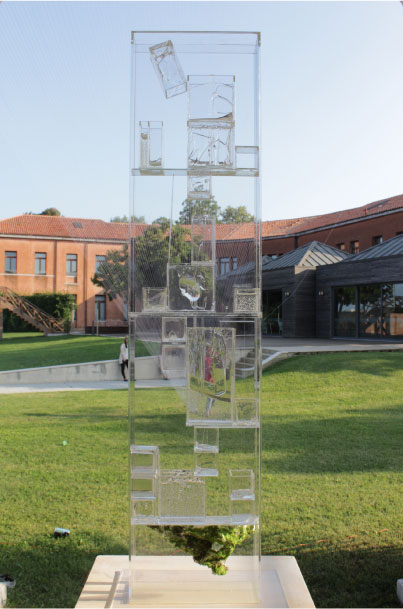
The Imitation of the Grand Silence, 2014, acrylic, ink, wax & clay, 28 x 10 x 120 cm
OPEN PRIZE
14th Edition
Special Prize to the
71st Venice International Film Festival
The OPEN Prize 2014 is awarded to
Rä di Martino
Award ceremony: Tuesday 2nd September 2014
Villa degli Autori, Venice Lido
Arte Communications launches the 14th edition of the OPEN Prize, on the occasion of OPEN 17. International Exhibition of Sculptures and Installations.
The institution of this award, conceived in 2000 by Paolo De Grandis and Pierre Restany, developed parallel to OPEN, the International Exhibition of Sculptures and Installations, which opens its seventeenth edition this year on 28th August. The prize will be awarded to a director taking part in the Venice International Film Festival whose work reveals, in an unprecedented way, a fruitful interest in the fascinating theme of the mutual interaction between art and cinema, two art forms which live on image and are nourished by the desire to express emotions.
The OPEN 2014 Prize, a work conceived and realised by the Artist Mark Aspinall has been awarded to Rä di Martino.
The jury, chaired by Paolo De Grandis, explained why he was chosen:
«To the works of Rä di Martino, a video artist who skilfully plays with the languages of art. His ironic and surreal gaze captures bizarre stories to tell tales of human fragility, among theatre, music, literature and the cinema. He judiciously articulates codes and quotations, moving expertly between the techniques and tools of the arts.
In particular, the cinema is both protagonist and object of investigation and reflection for Rä di Martino. So in his works we can catch, glimpse, perceive or stumble across stories, places, words, echoes of the cinema that has become a collective memory and thus a kind of alphabet: coded signs that tell new stories or new old stories in the artistic video dimension».
Previous winning directors were Joao Botelho with the film Quem es tu?,Julie Taymor with Frida, Takeshi Kitano with Zatoichi, Marziyeh Meshkini with Sag - haye velgard,Stanley Kwan with Changhen ge (Everlasting Regret), Jia Zhangke with Dong, Peter Greenaway with Nightwatching, Philip Haaswith The Butcher’s Shop,Michael Moore with Capitalism: A Love Story, John Woo, the Director Marco Müller, Robert Redford and Serena Nono.
The OPEN exhibition has been held for seventeen years, coinciding with the Venice Film Festival, confirming the precise intent to strengthen the bond that exists between art and the cinema; the creation of OPEN Prize bears witness to this close and fertile relationship.
